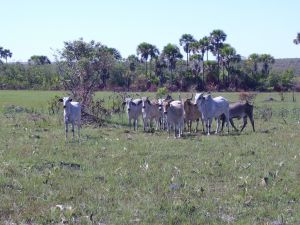
IBGE conducted an agricultural census in 2006, which aimed to portray the reality of Brazil Agrarian considering their inter-relationships with actors, sets, instruments and modes of action. This information, combined with the actual data of the flocks, relevant textual information and properly referenced, are those used to generate the analysis of agricultural data.

In relation to animal breeding in the target area, there is more than evident predilection for cattle, probably by promoting financial returns and also because it sets as effective use of occupied areas, serves as animal traction, cargo and capital reserves. The total cattle herd in the target area corresponds to 839,297 animal units (AU), and the municipalities of Formosa do Rio Preto (BA), Corrente (PI), Ponte Alta do Tocantins (TO) and Alto Parnaíba (MA) account for almost 50% this amount, respectively 14,43%, 13,92%, 11,75% and 8,87%. The cattle population accounts for more than half of the total, 402.551 cattle. Of these animals, the first 3 best placed municipalities in the effective of the total herd are also the largest holders of cattle – 55.420 (13,77% of cattle), 51.570 (12,81%) and 46.548 UA (11,56%), respectively - thus indicating the weight of cattle almost absolute count of farms.
The second most populous flock (roosters, chickens, pullets and poultry) corresponds to 26,77% of the total, although it is easier to create and develop faster than cattle. The chickens were third with 14,76% of the total, which should employ the same reasoning of second place. From the third flock, the importance of individual herds dissolves, leaving the breeding of pigs (3,98% of total), sheep (2,20%), horses (1,66%), goats (1,51%) mules, donkeys and buffalo (1,15% combined) with marginal importance. Barreiras do Piauí and São Gonçalo do Gurguéia (PI), Mateiros and São Félix doTocantins (TO) are the owners of smaller flocks in the total target area, with respective values of 16.730, 16.728, 13.305 and 10.025 UA, about almost 7%, is added, the total herd.
In regard of commercial plantations in the region practiced, there is a predominance in soybean, maize, sorghum and cotton, preferably in the sequence reported. The individual values of each of these cultures are not known municipally as it works to the IBGE this information in aggregate form by states. The table below shows the units of agricultural production (agricultural establishments) in the municipalities of the target area and the condition of production predominates.
According to Santos (2010) primarily agribusiness or agrobussines or limits its action to meet demands for commodities in national and international market. The family farm is the activity carried out by small or undercapitalized, that meets the needs of subsistence and local populations. For Kautsky (1980) and Girard (2008), small farmers offer their products in nearby markets and often because they can´t fit into the foreign market, are inserted in the agricultural economy so tied to agribusiness. It appears that 10.159 agricultural establishments in the target area there is a strong predominance of production conditions typified as family farms, more than 80% of sampled, on average. However, concern is the presence of agribusiness major municipalities to manifest in the Ecological Corridor, such as Mateiros, Lizarda and Almas, accented with percentages when compared with other municipalities: 41,86% of establishments, 36,97% and 32%, 61% respectively. Although these three municipalities represent a small portion of agricultural establishments (just over 5% of total), they are crucial in understanding local, regional and national coming to the region of Jalapão.